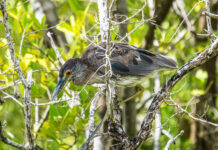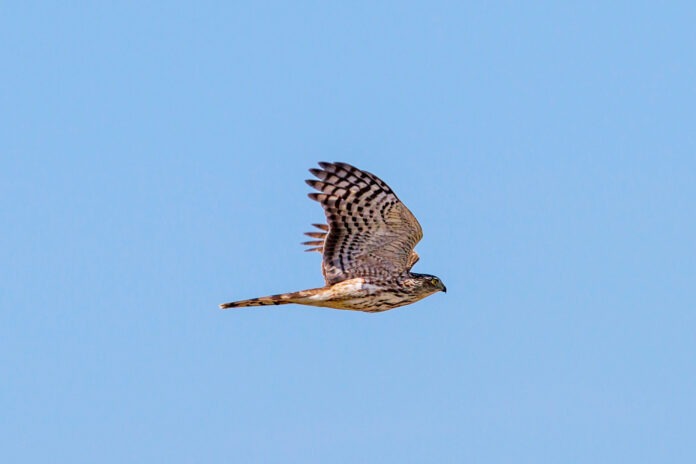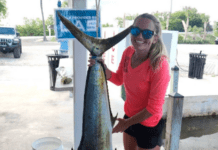I was sitting down on the back deck, hammering nails in planks, when I looked up into the mahogany tree and saw a shadow. It was high in the upper branches of the canopy and it was suspicious.
I’m pretty familiar with the things that move through the mahogany, and it wasn’t the plodding, slithery shadow of an iguana. It wasn’t the tentative please-don’t-notice-me motion of a mourning dove, or the I’ll-explode-in-a-panic-if-you-look-at-me-too-hard vibe of a white-crowned pigeon. It was too big to be a warbler or a mockingbird, and too small to be a vulture or bald eagle.
There was a confidence to the shadow, a matter-of-factness. Which made me think raptor, some kind of bird of prey.
I’ve seen short-tailed hawks and broad-winged hawks in the mahogany, but they usually prefer the lower branches. I was on the edge of making an educated guess when the bird squelched all the drama and stepped out onto a branch into the open, like an actor given a cue.
The bird was mostly brown, with a pale streaky breast and a kind of pointed face. And it looked a little stretched, a little skinny, an impression that was enhanced by the long tail with thick, alternating bands. Which made it either an immature sharp-shinned hawk or an immature Cooper’s hawk – two of the most notoriously difficult raptors to tell apart.
The difficulty lies in the fact that both species look nearly identical save for some minor differences – the Cooper’s hawk’s head sticks out more when it flies, giving it more of a flying cross look than the sharp-shinned’s flying hammer. The end of the Cooper’s hawk’s tail is rounded. The streaks on a Cooper’s hawk’s breast are dark and thin, where the ones on a sharp-shinned are ruddier and broader.
You can sometimes tell a Coop from a sharpy by size, as Coops, on average, are bigger than sharpies. But that’s on average. As is the case with most birds of prey, females can be up to 60% larger than males. So a female Coop and a male sharpy are pretty easy to tell apart, sizewise. But a female sharpy and male Coop can be close to impossible to differentiate by size, unless you find them sitting right next to each other on a branch. (This is something that very rarely happens as, outside of breeding and raising young, most raptors generally avoid each other’s company.)
The book “Hawks in Flight” by David Sibley, Clay Sutton and Peter Dunn was one of the first books to systematize raptor identification. In their discussion of how to tell Copper’s hawks from sharp-shinned hawks, they note that arguments about such tricky identifications “might account for more broken friendships and more failed marriages between hawk watchers than all other causes combined.” (Sadly, this sentence was not included in the text of the second edition. As if hawkwatchers still didn’t have differences of opinion.)
If I’d had a pair of binoculars in hand, or if my eyes were what they were 10 years ago, I might have been able to parse some of those finer parts. But I was reluctant to go dig out my binoculars because the bird might flush.
A few months ago I would have said “accips” to myself – accips being short for the genus accipiters – and filed it away in my mind that way. But that is no longer a valid response.
Cooper’s hawks and sharp-shinned hawks have adapted to become some of the most deft and daring fliers around. Their specialty is flying at high speed through close cover – forests, hammocks, large bushes, laundry lines – and brushing nary a wingtip on whatever obstacles throw themselves in front of them. This is all aided by their rounded and (relatively) short wings, and the long tail that acts as rudder and allows them to bank, juke and rocket through the world with an unparalleled agility, or at least an agility unparalleled by their prey items, which are primarily smaller birds.
We tend to see more sharp-shins than Cooper’s hawks migrating in the fall by two or three magnitudes. But in winter I see far more Cooper’s hawks than sharp-shins around Key West and the Lower Keys.
Unlike other birds of prey, Cooper’s hawks are not shy around humans when hunting. I’ve seen them nab chicks at the Old Town post office multiple times. Once, at Indigenous Park, I had a Cooper’s hawk take out another bird and drag it to the ground less than 10 yards from where I was sitting. And then she started eating it.
Occasionally I’ll run into someone who had a hawk take out another bird in their backyard and want to know what it was. I generally tell them there’s a 95% chance it was a Coop.
I’m pretty sure if one flew past you at high speed and you caught it on video, that if you slowed it down, the Coop would be giving you the finger with one of its primary feathers.
Sharp-shins’ and Coops’ mad skills and punk attitude has not always been appreciated. One otherwise enlightened writer of the 1920s referred to the sharp-shinned hawk as “the enemy of all small birds.” The 1936 edition of “Birds of America” described Cooper’s hawks as a species that “deserves destruction.” Arthur Cleveland Bent, writing about the Cooper’s hawk in 1937, said, “If the sharp-shinned hawk is a blood-thirsty villain, this larger edition of feathered ferocity is a worse villain, for its greater size and strength enable it to do more damage.”
Some of their old names were the small stub-winged bullet hawk and the large stub-winged bullet hawk.
Most of the historic animosity towards them comes from the fact that both Cooper’s hawks and sharp-shinned hawks were also often called chicken hawks, due largely to their habit of raiding the readily available food sources available at poultry farms – something that did not earn them the love of poultry farmers.
Getting back to being able to just mentally file the bird away by its genus, accipiter – it turns out you no longer can. While it has been thought for several centuries that the two species were close cousins, after some DNA analysis, it turns out they are not. The Cooper’s hawk was recently moved to a new genus on the evolutionary tree, the asturs. Which now makes the two species shining examples of convergent evolution, where two species from different branches of the taxonomic tree take on similar characteristics in order to adapt to the same ecological niche.
None of this makes it easier to tell Cooper’s hawks from sharp-shinned hawks, but it adds a nice new dimension to the confusion.

























